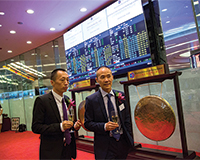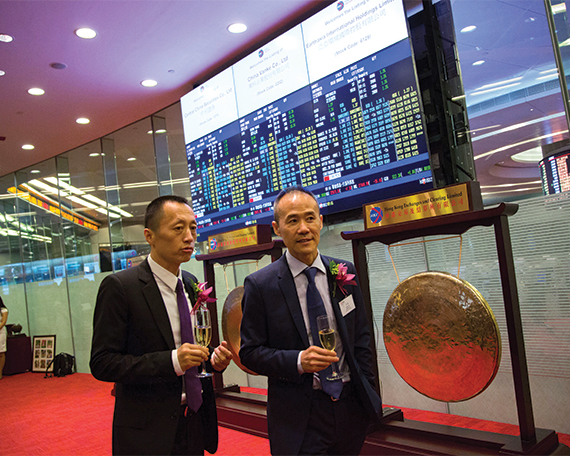China Vanke built roughly 150,000 houses in mainland China last year. That’s comfortably more than 10 times the annual number of houses sold by Britain’s biggest house builder, Barratt Developments, in 2013-14. In fact, it exceeds the total number of houses completed in the whole of the UK last year – 141,000, according to the Office of National Statistics. But the company isn’t just big by UK house building standards. It is the biggest China has ever seen.
Despite the sharp slowdown in the country’s housing market, China Vanke’s interim results for 2014 showed it had become the first Chinese developer to top RMB100bn (£10.8bn) of sales in half a year.
And now the group wants to enter the UK market. In the company’s first UK interview, head of global strategy, investments and new business development Charles Ma and the company’s newly appointed managing director for the UK Lily Lin explain the plan for London expansion and reveal why the company will do things differently to the Chinese developers that have already broken ground on British soil.
Grand-scale growth
Founded in 1984 by chairman Wang Shi (pictured above, right, with the company’s president, Yu Liang) in the south China city of Shenzhen, China Vanke’s rise has been relentless. Like many Chinese property companies, it started out as a conglomerate, selling everything from men’s suits to bottled water. But in the mid-1990s it began to specialise in property development, riding the wave of capital investment that fuelled China’s long real estate boom over the past two decades.
Today its market cap is RMB140bn and it has a presence in several overseas markets, including Hong Kong, Singapore and the US. The overseas expansion began in 2013 when the company signed a joint venture agreement with US investor and developer Tishman Speyer to build a pair of residential towers comprising 655 flats at 201 Folsom Street in San Francisco.
It has since begun work on a second US residential project at 610 Lexington Avenue in New York with partners RFR Holding and Hines.
“The approach to London and the UK will be similar to what the company has done in the US, at least in the beginning,” says Lin, who joined China Vanke from UBS in London at the start
of this year.
In broad terms, that will mean seeking out residential and mixed-use development opportunities, initially in central London, that offer a reasonable scale – at least £40m-plus, according to Lin.
So far, so similar to the Chinese developers already building houses in London, such as Greenland or Dalian Wanda.
The most eye-catching contrast to how its homeland competitors have approached the market will likely be in the company’s sales strategy.
“If you look at our Singapore, Hong Kong or San Francisco projects, we have been selling them mostly to local clientele,” says Ma, who heads China Vanke’s international business. “Around 90% of our San Francisco project was sold to local clients instead of overseas clients.”
And that is entirely deliberate.
Ma says the company is aware of the political rhetoric in the UK, where the sale of London flats to overseas buyers has become a contentious issue.
But he says the planned domestic sales strategy is about good business much more than it is about good politics.
“The reason is we want to have a very sustainable strategy in the long term and that means we want to create a product that works well in that local market.
“From our perspective, selling local developments all to international buyers is just not a sustainable strategy in any market.”
He cites the experience of developers from other Asian countries, such as Japan and Korea, that have based their overseas business models on selling flats in various markets to their native clients.
“They have all tried appealing to their local home buyers, but that trend typically drops off after five to seven years, so if you are looking to stay in the market for a long time, you need to establish a local reputation and really become a localised player,” adds Ma.
That long-term approach is reinforced by the company’s view that the London market is currently expensive.
On London time
While the timing of the US entry proved fortuitous, with China Vanke and Tishman underwriting the San Francisco scheme at $900 per sq ft (£592 per sq ft) and achieving sales at as much as $1,500 per sq ft, it is under no illusions that such IRR-busting deals are easy to find in London.
But as with its China business, it intends to avoid the worst of the toppy conditions by keeping clear of the oversupplied and overinflated super-prime end of the market.
Domestically, China Vanke is very much a mid-market player: while catering to all forms of buyer, given its enormous scale, it sells most of its houses to the middle classes.
Although developing in central London is not exactly “middle income” development, the company would be more comfortable underwriting schemes off values in the region of £1,000 per sq ft than it would be those in super-prime areas such as Belgravia, SW1, according to Lin, who refuses to be drawn on the exact parameters for the deals it would consider.
“The question to ask,” says Lin, a former banker who grew up in Los Angeles but has lived in London for the past eight years, “is, ‘could I afford to live here myself?’”
Prudence and price drops
Such prudence has served China Vanke well. The red-hot Chinese residential market has long topped lists of the biggest threats to the global economy and towards the end of 2013 it began to contract sharply after five years of astronomic growth.
The rate of contraction, which hit 4.3% in December, according to data from China’s National Bureau of Statistics, prompted the government to ease lending rules in the second half of last year in a bid to prop up the faltering market, which has been plagued by oversupply in many second- and third-tier cities.
Vanke has not been immune to the price drops and while its share price has taken a hammering in line with most listed Chinese developers – the company’s dual Shanghai and Hong Kong-listed shares typically trade at around a 30% discount to NAV – it is one of the few Chinese developers to boast an investment-grade credit rating, thanks to its efforts to reduce its debt burden and cut back on land acquisitions. As of September 2014, its debt-to-equity ratio was 46%, compared with an average of 67% in its peer group, according to Bloomberg.
And that comparatively conservative gearing, paired with its cash reserves of more than RMB50bn mean it is well placed to ride out the downturn.
“The market is definitely stabilising,” says Ma. “Continuous 30% growth year-on-year is not sustainable and it is actually not a healthy market state.
“In a healthy market you really want it to go through the regular cycles because that is natural. So, I think what we are seeing is the market becoming more natural, and from our perspective we actually welcome it.”
While China Vanke may have the balance sheet to withstand falling house prices, many of the thousands of real estate developers registered in China are much more reliant on bank debt and therefore at far greater risk of default.
“I think we will continue to see some smaller real estate developers get into distress because they have overleveraged and overextended themselves,” Ma says. “There shouldn’t be thousands of real estate developers, even in a country as big as China.”
But rather than posing the perceived systemic risk to the banks that financed them, these struggling developers will be a source of opportunity for China Vanke, says Ma.
Recent cases such as that of Kaisa, which defaulted on its overseas bond obligations after it became embroiled in the government’s corruption crackdown, suggest this may well be the case (Finance, p51).
Sunac China Holdings stepped in to rescue the company after it teetered on the brink, demonstrating the appetite for the company’s landbank despite the slow down in the regional housing market.
“What we have seen in the past is that there is always someone who is willing to gobble up these assets, including us,” Ma adds.
In some ways it might be surprising that China Vanke has not yet entered the UK market, given the Chinese downturn has prompted so many of its peers to diversify in London.
And it is not because the company has suffered from a paucity of opportunity. It has already held meetings with several major UK developers with a view to establishing local partnerships.
And there has been “no lack of shiny PDFs” for London development sites presented to the business either, according to Lin.
In true oil tanker fashion, the giant company has simply taken its time to prepare to enter the UK market.
But with a London representative now in place and a UK company already established, China Vanke is finally set to make a splash in London and, given its size, it is reasonable to expect it to be a big one.
jack.sidders@estatesgazette.com
China special:
• Briefing: Chinese investment – a bigger piece of the pie
• Finance: View from China – Kaisa-ra sera
• 2015: A year of promise and prosperity












